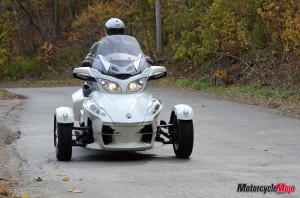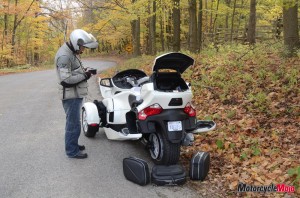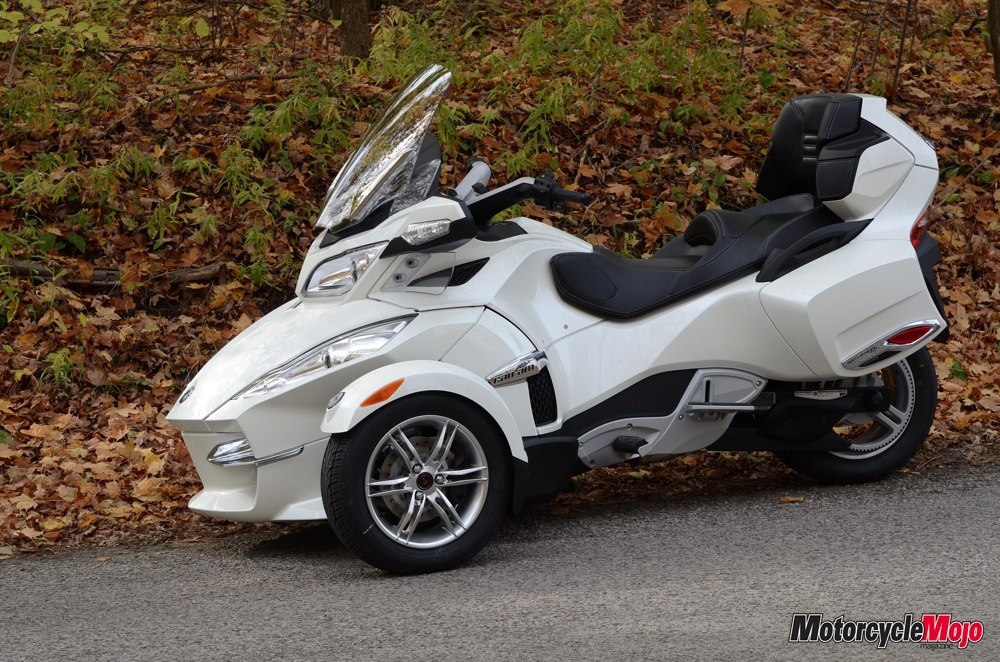“Is that a motorcycle?” The woman pumping gas into a pickup truck had been staring intently at my ride, and I knew it was just a matter of time before she would ask the question. I cringed when she did. “I don’t know,” was my weary, yet honest reply. “I’m still trying to figure that out myself.” Her eyes broke from the Can-Am Spyder RT Limited I was fuelling to look me in the face. “Whadda you mean, you don’t know?”
Three-wheeled motorcycles, or trikes, are nothing new under the sun. Despite a long history that includes the Depression-era Harley-Davidson ServiCar, homebuilt VW-powered customs, and thoroughly modern Lehmans, the trike remains an often maligned and misunderstood segment of the motorcycle landscape. Compounding the confusion surrounding the use of an extra wheel was the introduction of the Can-Am Spyder, which eschewed tradition by placing its dual wheels at the front of the machine. The Spyder, too, has taken its fair share of knocks from the purists, who like to describe it derisively as a snowmobile with wheels. Regardless of opinion, should trikes – and the Spyder – be considered subtypes of motorcycles?
 This would have to be settled by subjecting a Spyder to a Mojo road test. Our request for a Spyder RT from BRP, the Canadian manufacturer of Can-Am, produced a top-of-the-line RT Limited, delivered to our closest Can-Am dealer, St. Onge Recreation. Many features of the touring-grade Spyder RT differentiate it from the Spyder RS and RS-S models. Available in four levels of trim, an RT is most easily identified by the addition of panniers and a top box to its profile. Also common to every RT is an electrically articulated windshield, cruise control, and heated grips. Moving upscale in the model range, the RT Audio & Convenience adds an iPod-compatible sound system, additional instrumentation and heated pillion grab handles. The even higher-spec RT-S includes an electronically adjustable rear suspension, rear speakers for the sound system, fog lights, LED running lights and chrome trim work.
This would have to be settled by subjecting a Spyder to a Mojo road test. Our request for a Spyder RT from BRP, the Canadian manufacturer of Can-Am, produced a top-of-the-line RT Limited, delivered to our closest Can-Am dealer, St. Onge Recreation. Many features of the touring-grade Spyder RT differentiate it from the Spyder RS and RS-S models. Available in four levels of trim, an RT is most easily identified by the addition of panniers and a top box to its profile. Also common to every RT is an electrically articulated windshield, cruise control, and heated grips. Moving upscale in the model range, the RT Audio & Convenience adds an iPod-compatible sound system, additional instrumentation and heated pillion grab handles. The even higher-spec RT-S includes an electronically adjustable rear suspension, rear speakers for the sound system, fog lights, LED running lights and chrome trim work.
 Stealing the show is the RT Limited, with a grandiose list of features that scream that it’s a premium machine. For hardcore travellers, there’s a Bluetooth-ready Garmin Zumo GPS integrated into the RT’s electronics system and a custom-fitted travel bag inside each of the four storage compartments. The front storage bag doubles as a carry-on bag for air travel, with roller wheels and an extendable tow handle. An included travel cover shelters the machine when parked. More for show, the Limited’s mirrors, exhaust tip, heat shield, and six-spoke wheels have all been chromed, and there’s a specially embroidered seat to prove that you went all the way when it came to buying a Spyder.
Stealing the show is the RT Limited, with a grandiose list of features that scream that it’s a premium machine. For hardcore travellers, there’s a Bluetooth-ready Garmin Zumo GPS integrated into the RT’s electronics system and a custom-fitted travel bag inside each of the four storage compartments. The front storage bag doubles as a carry-on bag for air travel, with roller wheels and an extendable tow handle. An included travel cover shelters the machine when parked. More for show, the Limited’s mirrors, exhaust tip, heat shield, and six-spoke wheels have all been chromed, and there’s a specially embroidered seat to prove that you went all the way when it came to buying a Spyder.
Just sitting on the RT demonstrated another significant difference from an RS model: the riding position is far more upright and relaxed. With a more protective fairing, there’s no need to tilt into the wind on an RT like you do on an RS. Comfort proved to be exemplary, and even when loaded with two six-footers, there was plenty of room aboard the RT. The only surprise with its layout was the use of “pegs instead of footboards for the rider’s feet. The pillion position, on the other hand, is served by height-adjustable, folding floorboards.
The early winter conditions during the test had me questioning what I was still doing, riding so late in the year, but at least the sometimes frigid weather did provide a proving ground for the RT’s wind protection and heated handlebar grips. The grips can be set to either high or low. High provided plenty of heat even through the thick gloves I was wearing, and low worked well to maintain warmth. Slightly odd was the heated pillion grab handles; with an ample backrest and a supportive seat for the passenger, it’s unlikely that the grab handles will see a lot of use. A heated seat would have been a bonus for the rider, and made more sense than heated grips for a passenger.
I’m a big fan of electrically adjustable windshields and made good use of the one on the RT, moving it up during highway runs and down for around town. Being able to adjust it in small increments meant that I was always able to calm the airflow around me.
The RT’s dot-matrix instrument panel, updated for 2012 to improve its clarity, is controlled via the Roadster Electronic Command Center (RECC) mounted on the left handlebar. The multitasking display seemingly conveys every imaginable piece of information, including engine hour meters, a function I normally would have associated with Can-Am’s range of Sea-Doo watercraft.
It took minimal trial and error to figure out how to use the RECC and the myriad displays and options it controls. That I was able to intuitively figure out the in-depth electronic system without referring to a manual indicates the soundness of its design. My only complaint was with the RECC’s buttons, which were difficult to use while wearing thick, cold-weather gloves. Some menu items, such as time setting, were only accessible while the RT was stopped; undoubtedly, BRP’s legal department was concerned with the safety of riders distracted by the instrumentation. A more obvious example of BRP liability concerns is that the RT can’t be started until a rider presses its Mode button first, a procedure that acts as confirmation that the vehicle’s safety information has been read.
For a touring rider, 155 litres of stowage space will be the main argument for buying an RT. Although its matching luggage set is handy for toting everything into a hotel room during a trip, I found the front storage compartment most handy for day-to-day use. It can be unlocked by pushing a toggle switch and was big enough to swallow all of my riding gear, including a full-face helmet. The cubby bin located at the rider’s crotch is ideally suited for small items such as a wallet and cell phone, but I found the lid unlatched too easily, and opted instead to keep those items in my
jacket pockets.
Powering every Spyder is a proven, 998 cc Rotax V-twin, which for the RT has been recalibrated for touring duty by placing greater emphasis on torque (80 ft-lb) to handle the additional weight of a passenger and fully loaded cargo holds. On paper, the claimed 100 hp engine output seems underwhelming, especially for a machine the size and weight of a Spyder. In reality, I was surprised that it provided decent performance, and I had no qualms with the RT’s power; even though the engine obviously had to move a fair amount of weight, the RT accelerated hard enough to satisfy the needs of a touring rig.
A traditional 5-speed gearbox with reverse and a manual clutch is standard for every Spyder. The Limited on our test came with the optional semi-automatic system, which meant shifting was performed via two paddle-type buttons at the left handgrip. The system downshifts automatically if you forget to do so when slowing, but won’t upshift on its own. Gear changes made while remaining on the throttle were abrupt enough that I realized the semi-auto should be shifted like a standard transmission; rolling off the throttle whenever I tapped the shift button resulted in a seamless gear change every time. The reverse gear, essential on a three-wheeler, was easy to use. However, because it requires pushing two buttons simultaneously to engage, it can be a two-handed operation if you have smaller hands.
The RT uses a final belt drive, ideal for a touring-oriented machine. The setup, which requires less maintenance than a chain and weighs less than a shaft, was both smooth and quiet as it transferred power to the rear wheel.
Riding a Spyder is an experience like no other. Although there are similarities to traditional trikes, its handling through turns is very different. It’s a relaxing and easy machine to navigate when loping along at posted speed limits. But push the pace on a twisting road with the intent of stuffing it into a turn with gusto, and you’d better be hanging on – hard – not just with your hands, but with your legs as well. Riding a Spyder hard is not an easy proposition, but it is physically engaging and fun. Unlike motorcycles that lean in turns, three-wheelers track through them relatively level, and the resulting forces want to throw the rider off the machine toward the outside of the turn. Anyone familiar with snowmobiles will instantly compensate by riding with their bodies hanging off the machine toward the inside of each turn.
Unlike conventional trikes, the Spyder offers far more grip from its front end. Enter a turn too fast on other trikes, and the front wheel will literally be plowed sideways as the machine runs wide. With two front wheels, the Spyder has a lot more traction to turn harder, and the tires will howl in protest before they give up traction.
Underpinning the Spyder, and well hidden by its abundant bodywork, is a Surrounding Spar Technology (SST) frame, a proven design from BRP’s Can-Am ATV department, which is claimed to minimize weight and provide a lower centre of gravity. The RT’s chassis differs slightly from the RS by virtue of its wider track, no doubt a necessity considering its additional 104 kg weight and requirement to carry greater loads.
There’s no question that the RT provided a luxurious ride, in part because the rear shock’s pneumatically adjustable preload could be electronically controlled on the fly. A console-mounted toggle switch allows for incremental adjustments between hard and soft; although there was an appreciable difference between the two extremes, it would have been even better had it controlled all three of the RT’s shocks. There are also preset suspension settings accessible by the RECC based on whether or not you’re towing a trailer. Yes, Can-Am does sell a $4,999, colour-matched trailer for the Spyder, which provides an additional 622 litres of storage.
The front suspension consists of a double-A arm and a single shock at each wheel, which can be manually adjusted for preload. Despite the assistance of an anti-roll bar, the RT’s front end still exhibited considerable roll and would squat on its outside wheel when pushed hard through a tight turn. Despite the stresses placed on the chassis during demanding manoeuvring, the steering remained light at all times, a function of the RT’s Dynamic Power Steering (DPS), which electronically regulates varying levels of steering assist based on speed, steering angle and acceleration.
I’ve heard many complaints from those who don’t own a Spyder that the intervention of its sophisticated Vehicle Stability System (VSS) neuters the fun you can have on the machine. It’s nonsense. In truth, there’s no way that the Spyder would have passed safety testing without VSS in place; those complainers would likely be the first to lose control and ride the machine off a cliff without the VSS’s assistance.
Developed in cooperation with Bosch, the automotive-like VSS package combines the Spyder’s stability and traction controls with its ABS system to keep the machine from stepping out at the wrong time. The stability control system monitors the handlebar and throttle positions and compares intended direction with actual direction, reducing engine speed and/or individually applying brakes to a wheel to correct the course. Similarly, traction control senses rear-wheel rotation and will reduce the engine’s power output when it loses grip. Figuring out the parameters of VSS was entertaining, and I was surprised by some of the hooligan activity it permitted, like being able to hoist a front wheel through a turn.
Two features of the Spyder most likely to momentarily trip up long-time motorcyclists are its parking brake and lack of a front brake lever. Setting the parking brake on the RT through a console rocker switch was an easy task compared to the manual foot lever used on an RS. Equally strange for a motorcyclist is that braking for all wheels is performed with just a foot lever, as you would in a car. The brake system is linked, but is biased toward the front wheels. Backed by ABS, the brakes performed well, but lacked the feedback and ferocity of a high-performance system.
It’s unfortunate that some hold a very narrow view of what qualifies as a motorcycle and are quick to dismiss three-wheelers such as the Spyder, often for no other reason than it doesn’t lean. It’s a weak argument, because the Spyder embodies so many of the qualities that motorcyclists value highly, like the thrill of moving at speed fully exposed to the elements, and the sense of adventure that each ride provides. And for motorcyclists no longer able or willing to balance a heavy tourer, the Spyder RT represents a viable option to keep them riding and enjoying life on the open road.
There is no denying that the Spyder RT is brilliant at its intended purpose, to be an entertaining and innovative way to travel and experience the world. It’s built to a high standard with a particularly strong attention to detail, so the RT Limited isn’t cheap, but it is competitively priced when compared to luxury touring motorcycles.
After a lot of saddle time and a bit of internal debate, I now realize that I should have said yes to the woman at the gas station. The Spyder deserves to be called a motorcycle – even if it’s a three-wheeled version of one.
2012 Can-Am Spyder RT Limited Spec Chart
| MODEL | 2012 Can-Am Spyder RT Limited |
| List Price | $30,399 ($31,999 as tested) |
| Fitted Optional Equipment | SE5 semi-automatic transmission ($1,600) |
| Warranty | 2 years |
| Engine Type | Liquid-cooled, DOHC, 8-valve, V-twin |
| Displacement | 998 cc |
| Power (claimed) | 71 kW (100 hp) at 7500 rpm |
| Torque (claimed) | 108 N-m (80 ft-lb) at 5000 rpm |
| Bore and Stroke | 97 x 68 mm |
| Compression Ratio | 10.8:1 |
| Fuel Delivery | EFI with 51 mm throttle body |
| Transmission | 5-speed semi-automatic with reverse |
| Final Drive Type | Belt |
| Front Suspension | Two double-A arms, each with a single preload adjustable shock; one anti-roll bar |
| Rear Suspension | Single shock with electronic control of the pneumatically adjustable preload |
| Wheel Travel | 151 mm (5.9 in.) front; 145 mm (5.7 in.) rear |
| Brakes | Front: two 250 mm discs with four-piston calipersRear: one 250 mm disc with single-piston caliper |
| Wheelbase | 1708 mm (67.2 in.) |
| Tires | Two 165/65-14 front; one 225/50-15 rear |
| Weight (dry) | 421 kg (929 lb.) |
| Seat Height | 772 mm (30.4 in.) |
| Fuel Capacity | 25 L |
| Fuel Economy (observed) | 6.8 L/100 km (42 mpg) |
| Fuel Range (estimated) | 368 km |

























































